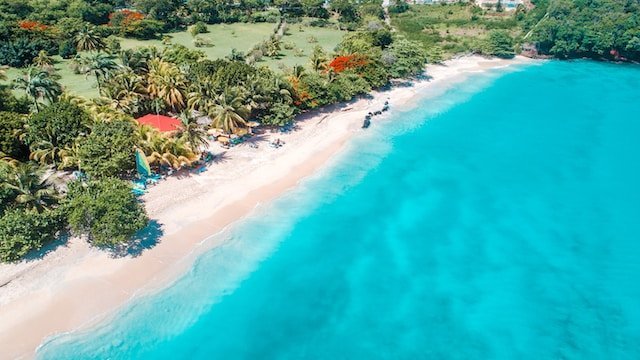Tips For Tenting In The Heat

They say the dog days of summer tend to be in August. Unlike our neighbors in the western part of the United States, our summer here in Pennsylvania has been very mild. When I say “mild”, I’m talking about some nights getting down in the 40s where I live. Most nights have been in the low 60s or high 50s. But not every night.
Recently we had our last camping trip of the season (sadness) and the week we scheduled turned out to be the most summer-like weather we have had yet. Heat and humidity were our constant companions. And no, we don’t have one of those air-conditioned RV’s. Oh no, we sucked it up and camped in a tent. While we were at it, we sucked up lots of moisture from the air, and the overabundances of mosquitoes, a natural result of our rainy summer.
Experienced tenters will already have some of these tricks up their sleeve. But here is what I have learned after several years of tenting.
1. Watch The Weather
If you live in an area that experiences unpredictable temperature swings (not unlike a hormone-driven teenager), then you need to be obsessively checking the weather about five days before your trip. The forecast can, and probably will change. But forewarned is forearmed, as they say. Apparently, whoever “they” are had better meteorology than we do now and could rely on what they were told.
2. Prepare
Better to be safe than sorry. Heat isn’t something to mess around with, especially with kids. Everyone can get worn down with constant whining. Worse, dehydration and heat exhaustion can be dangerous at any age. Pack lots of water. If you really want to snazzy it up, then pack some flavored seltzer water too. Stay away from sodas as sugar or sweeteners can make you feel more thirsty. We put our drinks in coolers and take a mortgage out on our home to pay for fresh ice every day. Still, when you are suffering through the sweltering heat, an ice-cold drink from the cooler can positively change everyone’s mood.
3. Plan Activities Accordingly
As the temperatures and humidity rise, you will want to adapt. No, I don’t mean growing gills on the sides of your neck, but hey, you do you. What I mean is that a two-mile hike through varying elevations should probably wait. Maybe change the hike to a less challenging route. Also, plan on doing strenuous activities early as possible in the day when it is much cooler. The rest of the day can be spent reading, playing board games, and trying to stay cool.
4. Keep It As Cool As Possible
Swimming is a major activity for my family. Well, most of the family. I won’t reveal any names, but there are those who sink like a rock and shouldn’t be in over their heads (you know who you are). The rest of us are fish. We love to be in the water swimming, playing, dunking (no, I would NEVER do that to my kids. Cough.), and staying cool. If you can plan your camping trip at a place that sports any kind of swimming hole, then do it. If swimming isn’t an option, then water guns never hurt anyone. Just sayin’. Not that I would EVER initiate a water gun fight with my kids. Cough.
5. Find The Shade
This can be difficult if you are reserving your camping spot online and have never seen the sites. Thankfully, we are within a somewhat easy driving distance of several state parks. My husband and I have a couple of parks where we try to reserve the same spot each year because we know it works well for our family. Other times, hubby and I give the kids a list of chores then drive off into the sunrise with a picnic lunch and check out the joint ahead of time. We creepily drive around the tenting sites, making notes of the ones that we think are optimal. We scope out the area for the best price on campfire wood and where to buy ice. Most importantly, we find the pool or lake. The best spot for tenting is one with partial shade. The trees serve as supports for a laundry line for drying towels and bathing suits. Also, they help keep the tent cooler. If you don’t have the opportunity to drive around the campground ahead of time, then make your best guess from the provided online maps.
6. Glamp A Little
More often than not I don’t have to worry about nighttime temperatures. When the sun goes down, the temperature usually drops enough for comfortable sleep. There are those pockets of days when the nights are stuffy and uncomfortable. In that case, don’t be afraid to bring some equipment. For our tent this year, I invested in two battery-operated lights with fans attached. They are small, and I doubted their effectiveness. Yet, they did pretty well in our tent at night. They weren’t super strong or anything, but they did help move the air enough for some relief. Another route you can go is to simply bring box fans. Of course, this will only help if you have an electric hookup or can bribe the squirrels to run in a cage to help generate power.
7. Take A Cold Shower
Even if you have been swimming all day and drinking enough water to startle a camel, you still might feel a little too hot. Most campgrounds have showers. Why not take a cold shower to bring your core temperature down? It is fast and effective and a great way to beat the heat, especially before hitting the sack. Or mattress. Or cot.
There are many more tricks of the trade, but these have been the simplest for us to follow. Someday we will go from tenting to RVing and have air conditioning at our disposal, but, we are very content and comfortable using our tent for now. Like my husband always says, camping should be fun. Anything you need to bring or do to make it enjoyable; you should do it.
Disclaimer: The above article is intended for safe, but uncomfortable, temperatures. If you are in an area where the outdoor temperatures exceed safe levels, exercise extreme caution. Safety should always come first!
“Camping—because therapy is expensive.”
~ author unknown
Photo courtesy of Gerd Altmann on Pixabay









